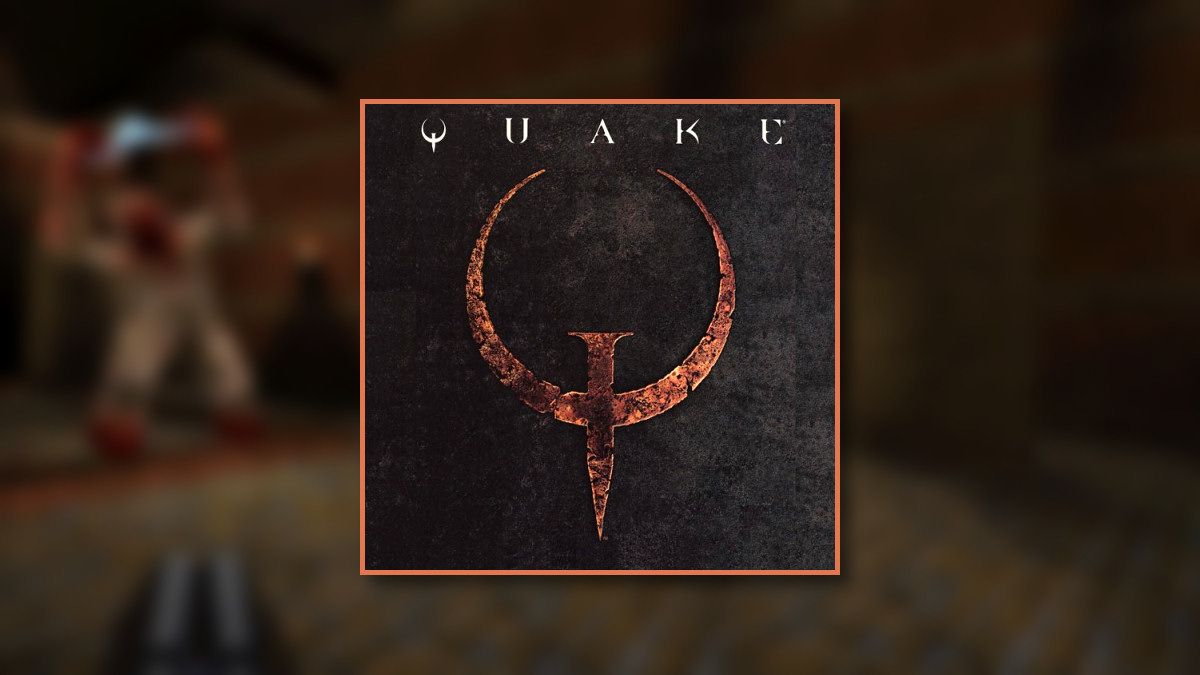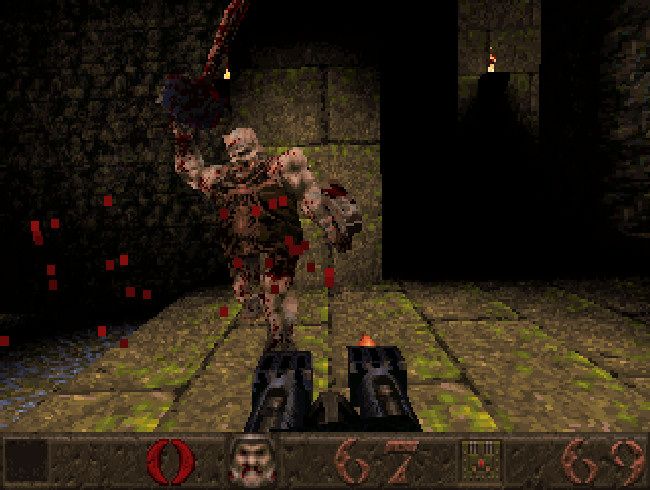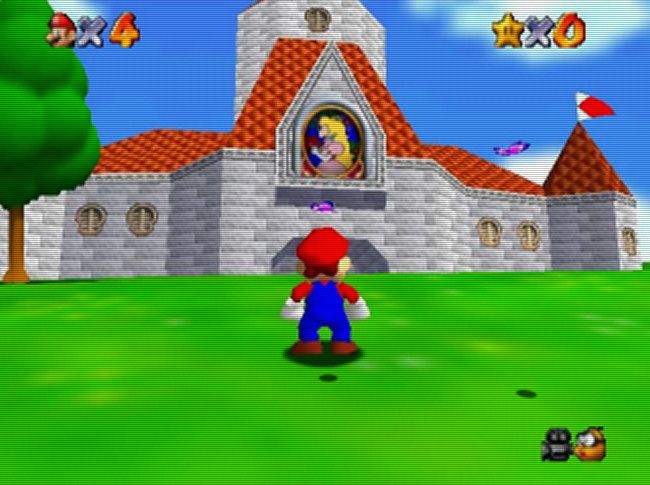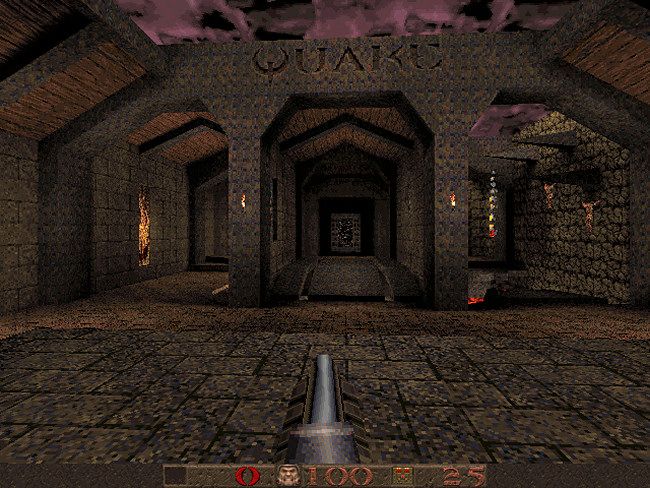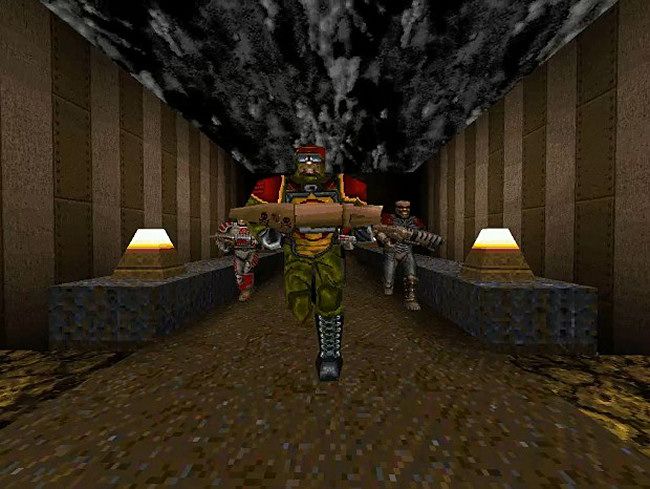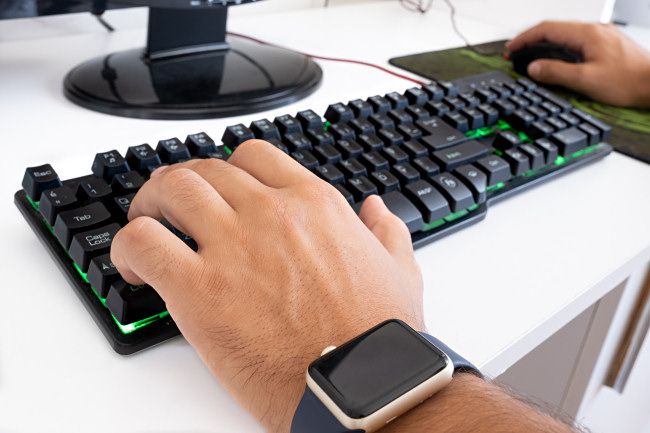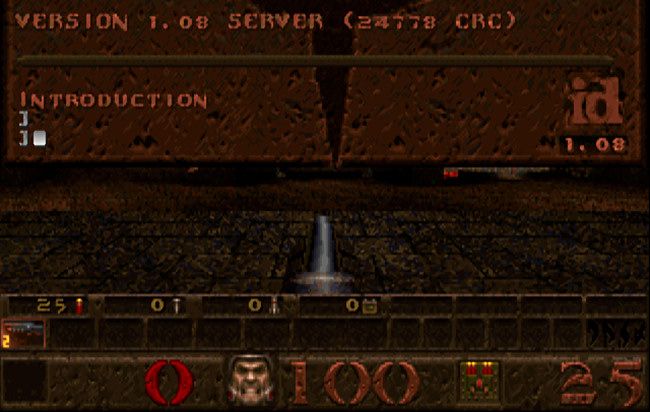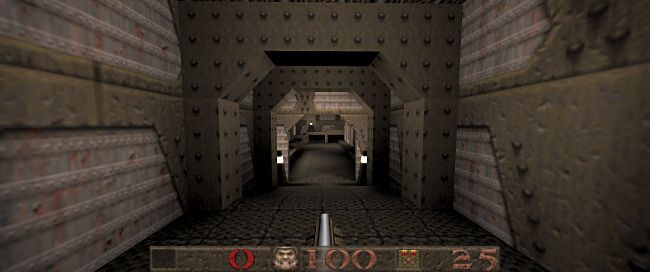Quick Links
After revolutionizing PC gaming with Wolfenstein 3D and Doom, id Software pulled off a hat trick with Quake, released on June 22, 1996. Quake mixed polygonal 3D graphics, networking, and grunge into a groundbreaking hit with wide influence. Here's what made it special.
A Gritty, Dark Fantasy World Created in Tension
In Quake, you play as an unnamed protagonist (later called "Ranger") who must travel through dimensional gates to defeat an alien named Quake that has invaded Earth. Like Doom before it, Quake is a first-person shooter game where you explore levels, solve minor puzzles, and obliterate every monster that you see---ideally in a shower of bloody "gibs."
Compared to the technicolor violence of Doom's universe, Quake felt relatively bland and dark, graphically speaking, and its single-player campaign was no showstopper. But it incorporated dark medieval imagery and H.P. Lovecraft influences that felt appropriate for 1996's era of grunge music, grunge fonts, and grunge fashion. And its pioneering 3D graphics and networking support placed it head and shoulders above the competition.
id Software forged Quake in a contentious team effort due to a long period of technical development on the engine, with disagreements over game design eventually leading to id Software co-founder John Romero leaving the company.
Still, the Quake team pulled off a major win for id Software. John Carmack, Michael Abrash, John Cash, Romero, and Dave Taylor handled the programming. John Romero, Sandy Petersen, American McGee, and Tim Willits designed the levels, and Adrian Carmack and Kevin Cloud created the graphics. Romero did game design, production, created editor tools, and worked on sound effects as well.
Notably, Quake features a creepy and compelling ambient soundtrack composed by Trent Reznor of the industrial rock band Nine Inch Nails. Reznor also voiced the sound effects of the main character. In tribute to Reznor's services, which he reportedly provided for free, id's artists put a "NIN" Nine Inch Nails logo on the nail gun ammo box in the game.
June 1996: Summer of the Polygon
Since Wolfenstein 3D, state-of-the-art first-person shooter games on PC generally used 2.5D graphics techniques to simulate height and depth while usually restricting player movement to a two-dimensional plane. Quake broke the mold by introducing a fully 3D polygonal universe populated with 3D objects and monsters, giving players six degrees of freedom in an immersive virtual world. Unlike 1993's Doom, you could look around freely (and even jump) in Quake.
"It was an obvious progression from Wolfenstein's three degrees of freedom to Doom's four degrees of freedom, to Quake's six degrees of freedom," Quake programmer John Carmack told How-To Geek. "Some Doom clones experimented with a shearing look up/down for five degrees of freedom, but if you are going to support arbitrarily oriented polygons, you might as well get all six."
Polygonal 3D video game worlds existed at least a decade before Quake, and even a polygonal 3D first-person shooter called Descent predated it in 1995. But in mid-1996, fully 3D video games were still rare, and action 3D games with in-game physics that could run with a decent frame rate on a consumer PC (without any 3D graphical acceleration) were unheard of.
Nintendo's Super Mario 64---released in Japan just one day after Quake---provided a fluid 3D world on the Nintendo 64 by utilizing special 3D graphics hardware. Both games revolutionized 3D polygonal gameplay in their respective genres, but Quake did it on your family's 75 MHz Pentium PC. Like Commander Keen, Wolfenstein, and Doom before it, Quake made a regular PC do more than what anyone thought was possible at the time.
In addition to its immersive 3D world, Quake played with dynamic light and shadow in a way never before seen in a computer game. "The lighting model was a more unique feature than the polygons," says Carmack. "There were other 3D polygon games and applications, but the light mapping and surface caching gave Quake a very different atmosphere."
By default, Quake usually ran at 320x200 resolution on an average PC in 1996. Higher resolutions were possible, but they required much faster CPUs. With the 1997 release of GLQuake---an official version of Quake that supported the OpenGL 3D graphics API---gamers could buy and use new 3D graphics accelerator cards to run Quake at higher frame rates and resolutions, effectively launching the GPU card era in gaming that we still have today.
An Online Cultural Juggernaut
Like Doom before it, Quake pushed the state-of-the-art when it came to multiplayer networked gaming. Doom introduced the FPS deathmatch to the world, but only through modem-to-modem connections, serial links, and local area networks directly. Quake was one of the first mainstream games to incorporate TCP/IP networking directly into the game itself, allowing people to type in an IP address and connect directly with a friend over the internet for co-op or competitive deathmatch play. Just months after Quake's launch, id Software introduced a QuakeWorld client that made internet multiplayer an even better experience.
Quake was also highly moddable, meaning that people who bought the game were allowed (and even encouraged) to build extensions off of it, make their own maps, and even extend the game engine in ways that the designers never thought possible. In this vein, id Software published its own programming language called QuakeC (used to develop Quake itself) that unlocked the engine for modders in a powerful way. After that, novel and influential variations of Quake's multiplayer modes emerged, such as capture the flag and Team Fortress.
As a result of its highly moddable nature, Quake also inspired some of the earliest forms of video game machinima, where people would use the Quake engine as a staging area to tell a story that would be recorded as a video and then (usually) shared on the internet.
Of eSports and Control Schemes
As a pioneering fully-3D FPS with in-game physics, Quake inspired emergent gameplay techniques---such as strafe jumping, bunny hopping, and rocket jumping---that required a high degree of skill to master. The competitive edge that these techniques gave over other players inspired Quake's use in video game tournaments, which many now consider a key step in the dawn of competitive eSports.
Quake also had a big impact on how we control PC games. Initially, many people played Quake with a keyboard like Doom. But the extra dimension of looking up and down gave players who adapted to mouse control a distinct advantage. The now-common "WASD" plus "mouselook" controls common in PC games became popular largely due to the play style of Dennis "Thresh" Fong, who won Quake tournaments in the 1990s. They weren't the default control mapping until Quake III in 1999, but players could easily remap Quake's controls to suit their tastes. Once they tried using WASD plus the mouse, few competitive players went back to keyboard-only gameplay.
In-Game Console Wizardry
To our knowledge, Quake was the first action video game with a built-in console interface used for changing game options and manipulating the engine itself. At any time during play on the PC version of the game, players could press the tilde (~) key, and a console box would drop down from the top of the screen with a prompt. In that box, you could type text commands that could move the player, manipulate the game world, change options, or enable cheats.
For example, by bringing up the console and typing
sv_gravity 100
, players could reduce the effects of gravity in the game engine and jump much higher. This was powerful stuff in 1996. It's just one more way in which Quake was almost more than just a game---it was a 3D-gaming platform unto itself.
The Legacy of Quake
Despite the struggles during its development, Quake was a hit out of the gate. Romero himself uploaded the shareware version of Quake to the internet for release on June 22, 1996. Word rapidly spread, and Quake sold several hundred thousand copies within a year of its release, reaching 550,000 copies by 1999, with reportedly over 1.8 million sold by 2010.
At least 10 games licensed the Quake engine, and, of course, the game spawned sequels in Quake II, Quake III, Quake 4, Enemy Territory: Quake Wars, and more. Through its cultural influence, Quake feels at least on par with games like Tetris and Super Mario Bros. as having cemented a genre and inspired future developers to take the concept much further than originally imagined.
As for id Software, Quake served as the swan song for the duo of Carmack and Romero, whose partnership spawned a wave of early 1990s PC hits that are still legendary. By the time id released Quake, Romero already knew that he'd be leaving the company---he wanted to do more than just first-person shooters. "The disagreement over whether we spend time exploring game design alternatives to FPS vs. just making another shooter is the reason why I decided to leave," Romero told us.
Still, Romero is proud of what Quake became. "The single-player game was pretty scary with the lights low and volume up," he says. "It's stood the test of time." He hosts Quake DeathJam events every year in Ireland, he notes, and the game is as popular as ever with competitive Quake players.
Likewise, John Carmack is also proud of Quake, but he sees how its creation might have progressed differently. "I am certainly satisfied with having made such an iconic game," he told How-To Geek. "With hindsight, I sometimes think we could have done better by doing all the modding and networking technologies with something closer to Doom's rendering engine so it would run faster for more people and be easier to map for, then do the full 3D maps and characters in another game a year later, but who knows---that might have been an opening for another company to pass us by."
But they did what they did, and no one passed them by that summer of 1996. Instead, id Software set the pace for the industry with Quake, and we're still talking about it 25 years later.
How to Play Quake Today
There's much debate online about the best way to play Quake today. Usually, the answer depends on whether you want a more "authentic" experience or one that utilizes advances in graphics technology since 1996.
If you don't want any fuss and have a Windows machine, browse over to Steam or GOG and buy Quake for about $5. You'll get the vanilla game with 1996-era options---no widescreen or gamepad support, for example.
But there are other ways to go. After id Software released the source code to the Quake engine in 1999, dedicated fans have created newer versions of the game engine called "source ports" that allow high-resolution textures, widescreen resolutions, modern controller support, and much more.
Among the many Quake ports available, QuakeSpasm (which runs on Windows, Macs, and Linux) remains popular as a vanilla solution with widescreen and Xbox controller support, while DarkPlaces supports more modern lighting effects and textures.
Either way, you'll still need to buy a copy of Quake online from Steam or GOG first (unless you have your vintage Quake CD), so that you can copy the data files over to the source port directory.
Have fun, and happy birthday, Quake!

